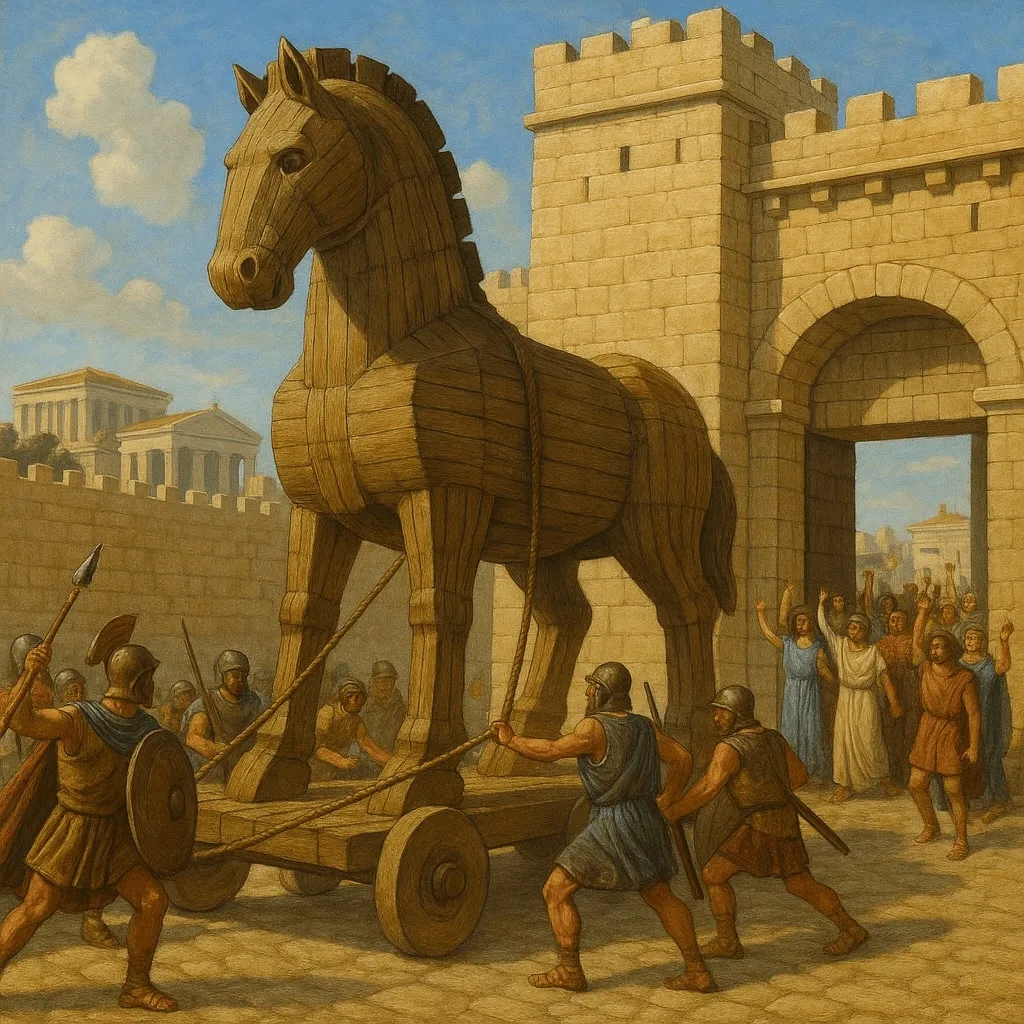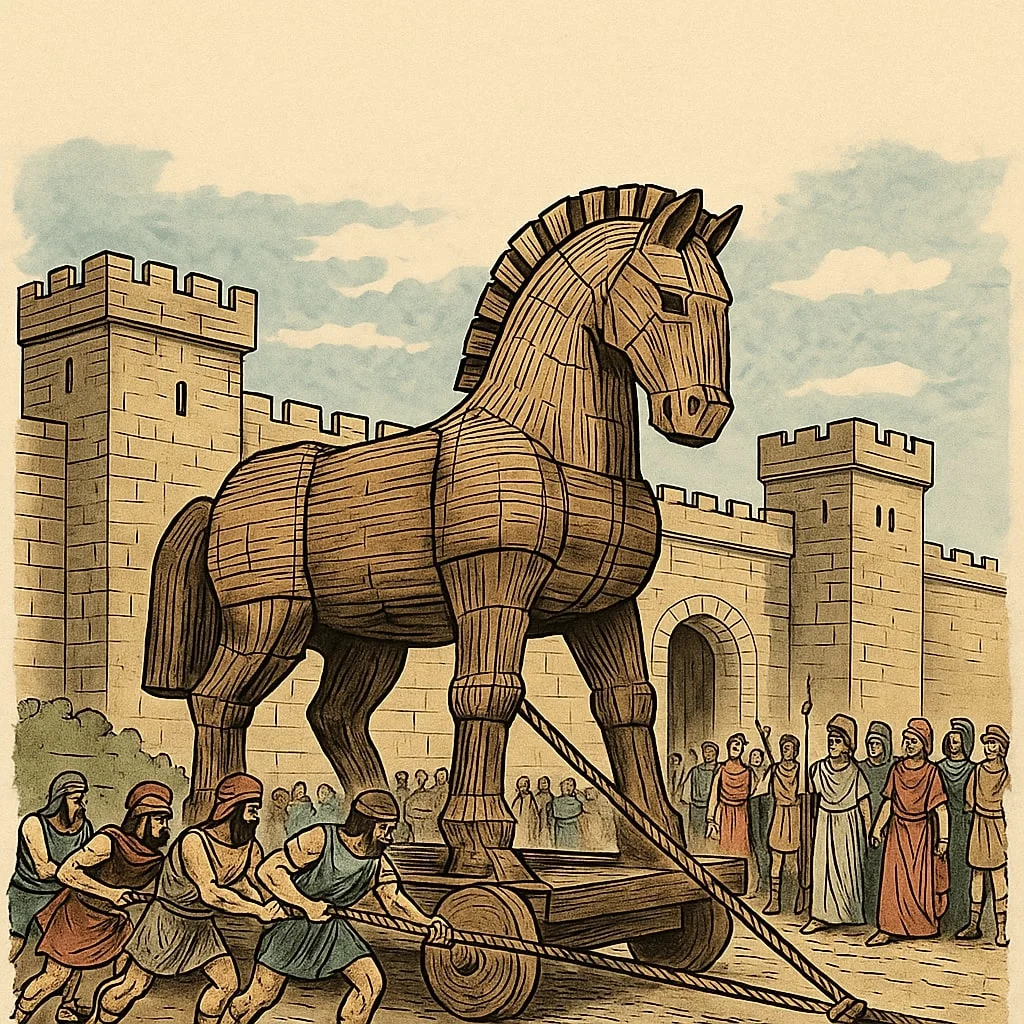The Trojan Horse story comes from ancient Greek legend. People often ask: “Trojan Horse story is it real or just a myth?” We know the city of Troy really existed, but historians say the wooden horse part is likely only a story. An Oxford scholar notes that the wooden horse was probably an “imaginative fable”. In fact, an encyclopedia points out that this story was written down centuries later, and “the extent to which [it] reflects actual historical events is not known”. In other words, Troy burned down, but the wooden horse itself is not proven to be real.
Story Behind Trojan Horse
So, here’s the story behind Trojan Horse. It all started after a long war, the Greeks used a clever trick. They built a huge wooden horse. Greek soldiers hid inside it while the rest of the army pretended to sail away. The Trojans thought the horse was a gift to Athena and brought it inside their city walls. Late at night, the soldiers hidden inside crept out and opened the city gates for their comrades. The Greek army then entered Troy and won the war. This is a famous story told for thousands of years.
This ancient Greek vase shows part of the Trojan Horse story. The horse has wheels and Greek warriors stand around it. Early storytellers even said the horse had wheels and ropes, just like this image suggests. In the legend, a Trojan priest named Laocoön warned to destroy the horse, but sea-serpents appeared and killed him and his sons instead. Frightened, the Trojans ignored the warning and kept the horse. That night, the Greeks hidden inside climbed out of the horse and opened Troy’s gates for the rest of the army.
Trojan Horse Explained
Could the story mean something else? Trojan Horse explained by some experts who quote:
- It might have been a siege weapon, like a giant battering ram or tower called a “horse”.
- It could symbolize an earthquake (in myth, Poseidon is god of horses and earthquakes).
- It may have been a ship carrying soldiers (“Homer calls ships ‘horses of the deep’”).
For all those who wonder if Trojan Horse story is it real or not, each idea shows how the Trojan Horse might really have been something else. In any case, the plan relied on Greek cunning. As one historian notes, it was a one-time trick meant to surprise the Trojans.
Trojan Horse Greek Story
In Greek tradition, the Trojan Horse appears in epic tales. Homer mentions it in the Odyssey, and Virgil later retold it in the Aeneid. In the Trojan Horse Greek story, Athena (goddess of war) appears to the builder Epeius in a dream and shows how to build the horse. The Greeks even left the horse as a gift to Athena, to trick the Trojans into accepting it. The myths also note that the Trojans were called “Tamers of Horses” because they bred many fine steeds. Hence, the Trojan Horse Greek story ends as the Greek heroes like Odysseus, with Athena’s help, used the horse to win the war.
Trojan Horse Story In English – Made Simple For You
Here is the Trojan Horse tale told simply: For ten years the Greeks besieged Troy. At last, the hero Odysseus had an idea. The Greeks built a giant wooden horse and hid brave soldiers inside it. They showed the horse at Troy and pretended to sail home. The Trojans believed it was a gift and took it inside their walls. That night, the Greeks inside climbed out, opened the city gates, and let the rest of the army enter. The Greeks then took over the city and won the war. This is the famous ending of the Trojan Horse story in English and as simple as possible.
Trojan Horse History Facts
Here are a few most common and widely accepted Trojan Horse history facts:
Where Troy was:
The ancient city of Troy was real and located in what is now northwestern Turkey, near the narrow Dardanelles waterway. It guarded the only sea passage between the Aegean and Black Seas, so Troy’s rulers could watch and possibly tax ships passing through. Archaeologists began digging at Troy in the 1870s (led by Frank Calvert and Heinrich Schliemann) and confirmed its ruins at a place called Hisarlik.
Excavations at Troy:
Digging at Hisarlik revealed nine distinct city levels (Troy I through Troy IX) built one on top of another. Each layer was a city that had been destroyed and then rebuilt above the rubble. For example, Troy II was destroyed by fire (Schliemann’s “Priam’s Treasure” layer) and a new city was built on top. Today we see the remains of those layers (stone walls, floors, and burned debris) at the Troy excavation site.
Troy VI:
One of the late Bronze Age cities (Troy VI, c. 1700–1275 BCE) had huge limestone walls (about 5 m thick) and grand houses. Troy VI even had stables for horses. Around 1250 BCE this city was destroyed by a massive earthquake, collapsing walls and buildings. (This makes Troy VI too early to match the later Trojan War legends.)
Troy VIIa:
The survivors quickly rebuilt. The next city (Troy VIIa, c. 1275–1200 BCE) was smaller and much more crowded, with many houses jammed together and large storage jars sunk into floors – a sign that people were preparing for a siege. Soon after, around 1250–1200 BCE, this Troy VIIa was destroyed by fire. Archaeologists found burnt houses filled with ashes and human bones, plus charred wood and arrowheads. These finds strongly suggest that enemies attacked and burned the city.
Evidence of battle:
In the Troy VIIa destruction layer, many Mycenaean-style weapons were found. For example, arrowheads and spear points made in the Greek (Mycenaean) style were uncovered by archaeologist Carl Blegen. He saw this as evidence of a Greek attack. However, later study showed that by about 1200 BCE Mycenaean kingdoms were collapsing, so a huge Greek army as described in legend is now thought to be unlikely. Still, the burned buildings, skeletons, and weapons together make clear that Troy suffered a real Bronze Age war.
Hittite records:
Clay tablets from the nearby Hittite empire (in Anatolia) mention a city called Wilusa (believed to be Troy) and a kingdom called Ahhiyawa (likely the Mycenaean Greeks) fighting in the 13th century BCE. One tablet speaks of a ruler “Alexandros” (like Paris of myth) of Wilusa. Others say Wilusa was claimed by both the Hittites and the Ahhiyawans (Greeks). This shows Troy was caught up in real political and military struggles of that time.
Strategic trade route:
Troy’s spot was extremely important for trade. It sat at the entrance to the Dardanelles, the only sea route between the Mediterranean and the Black Sea. Controlling Troy meant you could control sea traffic and charge tolls on ships carrying goods. Scholars think this strategic position was a likely cause of conflict – both Hittites and Greeks wanted this trade point.
Homer’s epic poems:
The earliest written accounts of the Trojan War are Homer’s Iliad and Odyssey, composed about the 8th century BCE. Homer (or the oral poets before him) mixed real places and events with stories of gods, heroes, and monsters. The Iliad is set in the final year of the war and describes Greek heroes (like Achilles) and Trojan heroes (like Hector). But Homer wrote these tales hundreds of years after the Bronze Age, so they are literary legends not eyewitness history.
Wooden Horse myth:
The famous story of the giant Trojan Horse is almost certainly a legend, not a historical fact. Archaeologists find no evidence that such a wooden horse was used. One explanation is that the tale came from descriptions of siege engines (wooden war machines). For example, some scholars note that Greeks sometimes covered battering rams with soaked animal hides (“horse-hides”) to protect them from fire. In any case, modern experts treat the Trojan Horse as an imaginative story, not a real weapon.
Recent discoveries:
New digs at Troy continue to uncover clues. In 2025, archaeologists found burnt deposits, piles of small pebbles (sling bullets) and buried skeletons in the Troy VI–VII area. The stones, concentrated in front of the palace walls, were used as ammunition for slings. This kind of evidence (burnt ruins, armor, sling stones) points to a violent siege or battle in the Late Bronze Age. Researchers say these finds strengthen the case that Troy really was attacked, even if the exact story (with gods and Helen, etc.) is legendary.
Trojan Horse Greek History
As per Trojan Horse Greek history, the Trojan War is dated to the Bronze Age (around 1200 BC). This was long before any writings were made. Centuries later, Homer and other poets told the story, mixing history with myth. The Trojan War and Horse became central to Greek culture. But as modern historians agree, the story is mostly legendary. We know the war was part of distant Greek history, but the horse itself belongs more to myth than to confirmed history.
Trojan Horse Story Is It Real?

So, Trojan Horse story is it real or just a myth? The answer is mixed. The city of Troy was definitely real, but the famous wooden horse was likely only a story. Scholars admit we can’t be sure if the horse trick ever happened. Today we call the Trojan Horse a great ancient myth, not a confirmed historical event.




